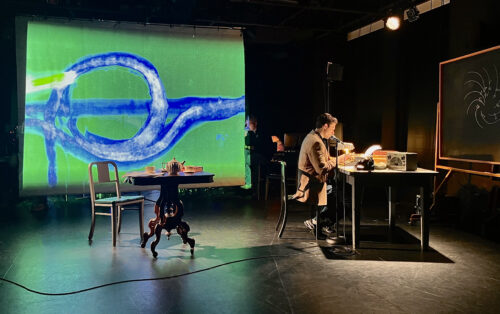Image Courtesy of Jean-François Monette.
Composer Matthew Suttor and the team of artists and programmers behind the experimental opera I AM ALAN TURING have welcomed artificial intelligence (AI) as a collaborator. The opera’s libretto blends human-generated and machine-generated lyrics and dialogues to explore the life and ideas of brilliant computer scientist Alan Turing. Supported by Yale’s Center for Collaborative Arts and Media (CCAM), the project presents a new model for creating opera in the information age and explores what it means to be human in light of AI.
Suttor, program manager at CCAM and senior lecturer in Theater and Performance Studies at Yale, was amazed by Turing’s insights on AI while exploring the archive at King’s College, Cambridge, a few years ago. In his 1951 lecture “Intelligent Machinery, A Heretical Theory,” Turing argued that it is possible to construct machines that closely simulate human behavior. Yet, humans should not be afraid of being replaced. “There would be plenty to do, trying to understand what the machines were trying to say,” Turing wrote.
Renowned for his work on deciphering Nazi codes during World War II, Turing laid the groundwork for modern computing and AI. In 1936, he introduced the first theoretical description of a computer, the Turing machine. In 1950, he proposed the Turing test, which gauges how well a machine can think like a human. If a human cannot distinguish between the answers of a machine and another human, then the machine has passed the test.
Suttor first proposed the opera to a group of collaborators in 2019. “Right from the very beginning, there was this idea of the opera being some kind of Turing test for the audience, so it had this meta kind of framework,” Suttor said. It was then that Smita Krishnaswamy, associate professor of genetics and computer science at Yale, introduced Suttor and his team to representatives of OpenAI.
At the time, GPT-2 was OpenAI’s latest large language model (LLM)—an AI trained to understand and generate natural language—but it lacked chat capabilities like its most famous successor, ChatGPT. With assistance from Yale University Library’s Digital Humanities Lab, Suttor’s team created an interface to interact with GPT-2. Through Zoom calls in 2020, the team trained the model on various large text datasets and fine-tuned it using Turing’s writings. They then posed direct yet philosophically profound questions to the model, such as “Can computers think?” They experimented with different settings of temperature—the randomness of the output—and the number of characters produced, and they almost immediately obtained interesting answers.
The team embraced the AI as an artistic collaborator. “Asking questions is also a form of training,” Suttor said. “Interacting with an LLM forces you to ask better questions.” Discussing the AI’s outputs was extremely valuable for the team from a pedagogical point of view and was a powerful exercise in collaboration.
The opera’s title originated from one of their earliest conversations with GPT-2. When asked to produce lyrics for a “sexy” song about Turing, the AI came up with “I’m a Turing machine, Baby.” The AI is so integrated into the opera that even Suttor and his team cannot tell machine-generated text apart from human-generated text.
Beyond the libretto, the opera incorporates AI and aspects of Turing’s work in other areas. Some AI-generated images of Turing, Suttor, and his team are used throughout the production. GPT-2 was also used to write code snippets for creating animations featured during the performance. Even Turing’s later works on mathematical biology come into play. Based on Turing’s diagrams of spiral patterns in sunflower seeds, Suttor created unique harmonic progressions by tracing equivalent spirals onto the circle of fifths, a method of organizing pitches in music theory. These progressions underpin much of the opera.
Suttor and his team recently presented a work-in-progress performance of I AM ALAN TURING at the CCAM as part of the Machine as Medium Symposium: Matter and Spirit. The event explored how AI and creativity intersect and give rise to new approaches to timeless questions about human existence.In its current form, the opera spans eight music pieces across various genres, but there’s still more work to be done. Suttor is excited to see how the project continues to evolve through workshops and collaborations between humans and machines. In light of the latest AI surge, I AM ALAN TURING serves as a testament to Turing’s enduring influence and the boundless possibilities when art and technology converge to explore the essence of humanity.

